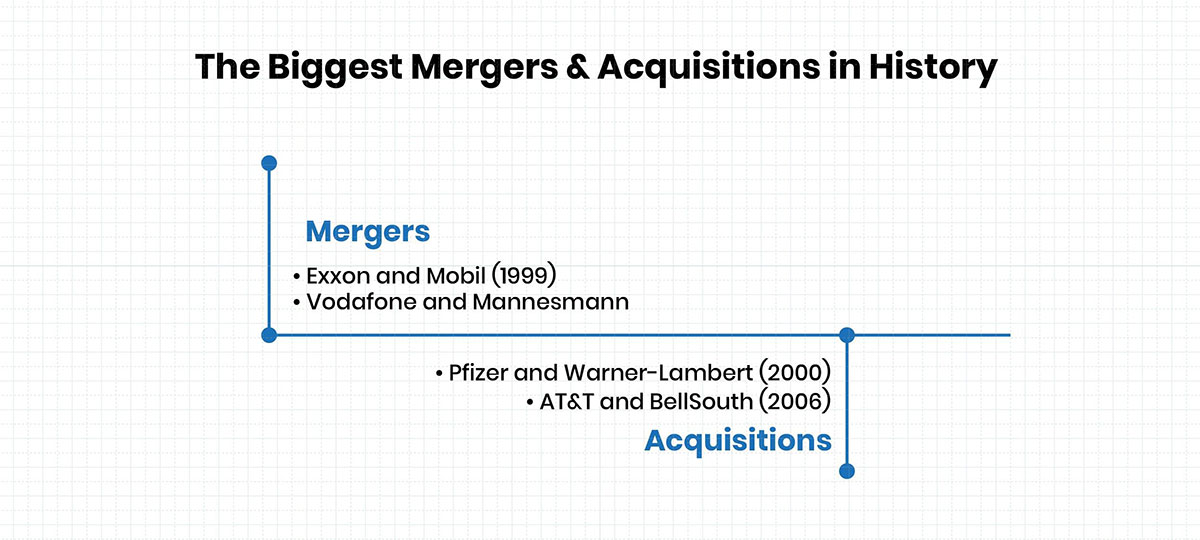Introduction
The process of Mergers and Acquisitions (M&A) is significant for the formation of the business environment, creating new opportunities, and promoting innovation in the economy. Such strategic decisions tend to shape some of the largest companies in the business world. This article focuses on the largest mergers and acquisitions in the world, considering their ramifications on the economy and industrial sector and the role played by investment banks. Learning about such huge transactions allows the learner to comprehend the challenges and prospects of their investment banking career choice.
What are Mergers and Acquisitions?
Mergers and acquisitions (M&A) are among the most significant techniques in the business environment, since they enable the realization of growth, increased stake, and innovations in the market. A merger means that two companies are joined as one, while an acquisition means one firm buys out the other. These processes can drastically change industries and largely impact the economy.
Key reasons companies pursue M&A:
-
Market Expansion: New opportunities for attaining greater market shares and sizes.
-
Economies of Scale: Employment of cross functions to combine operations thus cutting costs.
-
Diversification: Drawing less risks to enter new segments or industries.
-
Synergy: Integrating activities to achieve higher efficiency and effectiveness of performance.
Investment banks are important in M&A, as they offer advisory, appraisal, and purchase-related services that include evaluation, negotiating, and deal structuring. Knowledge of such aspects is important to comprehend the more general tendencies of M&A transactions in the worldwide economy.

The Biggest Mergers in History
The largest mergers foresaw revolutionary changes in industries, the formation of large dominant companies, and brought powerful impacts on the world economy. These great mergers— always characterized by large financial stakes and positioning of companies— best depict the potential of mergers and the importance of synergy in business competition and development.
Exxon and Mobil (1999)
Exxon and Mobil joined together in 1999 to form one of the biggest companies in the industry, which led to the revolution in the corporate world. By size and positioning the merger altered the conditions in the industry and became the model for future mergers and optimized efficiency.
-
Background of the Companies: The previously known brands of Exxon and Mobil were Standard Oil of New Jersey, and Standard Oil of New York respectively, originating from the Standard Oil Company owned by John D. Rockefeller. Upon the completion of the merger, they both formed among the three biggest oil firms globally.
-
Details of the Merger: This merger was declared in December 1998, and it was successfully done in November 1999; valuing at about USD 81 billion, making it one of the largest corporate mergers.
-
Impact on the Industry: The merger paved the way for other consolidations within the oil and gas industry, making it focus more on its performances, efficiency, and laboratory and cost-driven factors.
-
Regulatory Challenges: A lot of attention was paid to the regulatory sanctions of different countries, such as in the USA, where the Federal Trade Commission insisted that the companies would have to sell some of their assets to prevent unfair competition.
Vodafone and Mannesmann
The Vodafone Mannesmann deal in 2000 represents one of the most significant and large M&As in corporate history, not to mention the strategic considerations involved in cross-border mergers. It brought focus on the importance of telecommunication to international commerce and new records in terms of transaction value and cross-border M&A deals.
-
Background of the Companies:
Market leader Vodafone still had that goal of conquering the remaining portions of the world based in the United Kingdom. Mannesmann was a German Telecoms company that was fully innovative , and reputed in many European countries.
-
Details of the Merger:
In 1999, Vodafone launched a hostile takeover bid for Mannesmann. Initially rejected, Mannesmann later agreed to a record bid of USD 183 billion, which was the largest takeover at that time.
-
Impact on the Industry:
The merger shaped a vast telecommunications industry with extensive facilities and diverse subscribers from the European community and beyond. It was a precedent for large-scale international mergers, as well as changing the structure of competition in telecommunications.
-
Integration Challenges and Successes:
When implementing changes, managing two corporate cultures and the organizations’ operational structures was a major concern. However, strategic alignment and synergy in both technology and market positions ended up causing significant operational improvements and improved services.
The Biggest Acquisitions in History
In the field of business and corporate governance, mega deals define industries and nations. They are characterized by their volume and significance, alter market, and corporate profiles. Analyzing such big deals can help understand strategic management, financial capabilities, and the long-term impact of large corporations on the markets.
Pfizer and Warner-Lambert (2000)
In 2000, Pfizer finalized the acquisition of Warner-Lambert in the largest deal of its kind that cost about USD 90 billion. This was one of the biggest mergers in the pharmaceutical industry’s history and was supposed to add a great deal to Pfizer’s range of products. At the heart of the transaction was Warner-Lambert's crown jewel, the now-famous cholesterol drug Lipitor, which stayed the bedrock of Pfizer’s revenues for many years to come.
-
Background: Pfizer is a company that was established in 1849 while Warner-Lambert was founded in 1856; both these companies were established in the pharmaceuticals niche and had proved to be industry giants with operational competence and massive market experience.
-
Deal Details: It was affected in cash and stock options at USD 105 per Warner-Lambert share that revised the company’s value at a higher price compared to what the market offered. The operation was initially unsuccessful and legally disputed, but it created strong foundations for Pfizer in the sphere of worldwide pharmaceuticals.
-
Impact: The introduction of Lipitor to Pfizer’s product strengthened the company's revenue and became one of the most popular drugs in the world. This acquisition also helped Pfizer in gaining a strategic position in cardiovascular health, which is a major area of focus now.
-
Industry Influence: Apart from the monetary objectives, the Pfizer –Warner-Lambert merger paved the way for mega-mergers in the pharmaceutical industry. It highlighted the relevance of acquiring high-growth drugs and transformed the balance of power among leading global pharmaceutical companies.
AT&T and BellSouth (2006)
In 2006, AT&T bought out BellSouth in a historic transaction worth about USD 86 billion to seal its huge telecom empire. This acquisition was a strategic one with a view of extending the service delivery and geographical network of the firm in the United States of America.
-
Strategic Integration: Combining AT&T with BellSouth assisted in the acquisition of BellSouth’s large network infrastructure making service capabilities and coverage across the country better. This integration ensured that there was easy communication, and overall, enhanced service provision to millions of clients.
-
Regulatory Hurdles: There was a significant level of regulation from several bodies , in anticipation of the merger, the FCC and the Department of Justice among them. These difficulties were managed by negotiating and pledging around certain interests in maintaining competition within the market, by AT&T.
-
Market Impact: After M&A, AT&T further enhanced its competitive standing and made itself one of the leading telcos in the world. The acquisition allowed AT&T to have a diversified revenue and a large operational scale therefore placing it strategically in the new telecommunication industry.
-
Financial Implications: By getting a hold of BellSouth, AT&T was also able to repair its financial positions, overall increasing its revenues and the value of shareholders. As with other cases where synergies are obtained through mergers, operational efficiencies, and cost savings were realized, making AT&T one of the market leaders in the telecommunications industry.
The Role of Investment Banks in M&A
The M&A process involves strategic planning, valuation, analysis, and structuring, which are executed by investment banks. They offer relatively experienced manpower, especially in dealing with the contractual conditions and the legal frameworks surrounding a venture. The profession of Investment banking involves providing guidance to clients with the optimization of value and avoiding possible failure, thus, making investment banks crucial for strategic development through the greatest mergers ever and the largest acquisitions of all time.
Conclusion
Analyzing the largest mergers and acquisitions in history provides a deep understanding of the trends in corporate strategy and expansion. Such gigantic deals not only redefine industries but, more importantly, also point to the critical function of investment banking in such value-creation ventures. The involvement of investment banks underlines the significance and complexity of M&A, which in turn makes this activity a hallmark of the investment banking career path.

